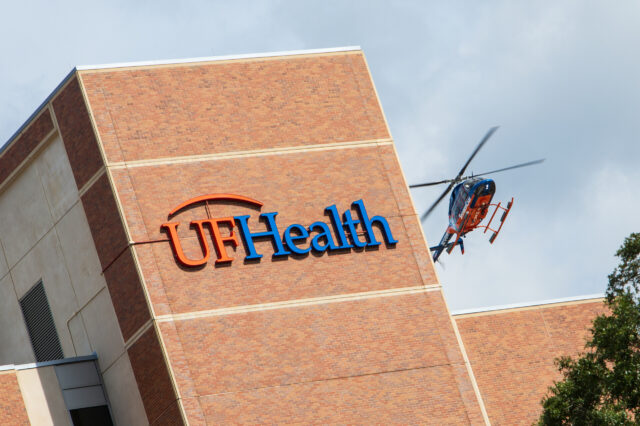UF Health admits more patients from Panhandle hospitals, provides other help

As UF Health Shands Hospital was caring Friday for 36 patients from hurricane-damaged Panhandle hospitals, other UF Health groups and experts were directing search-and-rescue teams and preparing to help injured animals.
On Friday afternoon, UF Health emergency medicine physician Benjamin N. Abo, D.O., remotely directed a team of 80 people and five dogs assigned to Florida Task Force 1 Urban Search & Rescue Team. The team was near Panama City looking for people reported missing and assessing the local infrastructure, Abo said. The FL5 Disaster Medical Assistance Team and others were working to establish a mobile hospital at storm-damaged Bay Medical Center Sacred Heart in Panama City.
“Most people evacuated but there is a lot of devastation and a tremendous loss of infrastructure,” Abo said.
At the UF College of Veterinary Medicine, the animal rescue and disaster response teams were preparing to deploy. A typical team includes about 12 members but can be expanded up to 40 people if needed. The college also has the ability to evaluate animals in the field and establish a self-contained hospital with basic surgery capabilities. Its technical rescue team aids helpless animals in many different situations, including large animals mired in mud, flooded areas and sinkholes.
The teams were awaiting directions from state officials Friday afternoon.
“We’re sure there’s a lot of work to do. It’s just a question of establishing the best location,” said Karen Adams, facility operations manager for UF Veterinary Medicine and the branch director for the UF|VETS disaster response team.
A group that provides fatality management services during disasters also has been activated, said Bruce Goldberger, Ph.D., director of UF Health Forensic Medicine. The Florida Emergency Mortuary Operations Response System is managed by the UF College of Medicine’s department of pathology, immunology and laboratory medicine. It includes volunteers from around the state who assist with mass fatalities when local resources are exhausted.
While some groups ramped up, UF Health ShandsCair pilot Brian Tison was getting a bit of rest Friday afternoon. Tison, who pilots the Gainesville-based ShandCair 1 medical helicopter, logged four and one-half hours of flight time beginning at dawn Thursday. After an 80-minute flight to Panama City, Tison and the flight crew brought patients from Bay Medical Center — one each to UF Health Shands Hospital and a Pensacola hospital.
As Tison closed in on the Panama City airport, he saw houses with their roofs peeled off and outbuildings that were leveled. Farther south at Bay Medical Center, Tison found a usable helipad amidst the hospital’s partially skinned exterior. The roofs of many homes in a subdivision were gone, and probably 80 percent of nearby trees were down.
“It looked like a bomb went off. There wasn’t a leaf left on a tree anywhere,” he said.
After a mandatory 10 hours off, Tison was preparing for another 12-hour shift starting Friday evening.
“I continue to be impressed by the ShandsCair team’s professionalism,” he said.
Thursday’s flights left an indelible impression on Tison.
“It was shocking. I was in awe of the sheer power of what that storm did,” he said.
Ed Jimenez, CEO of UF Health Shands, said he was proud of the commitment of physicians, nurses, clinical staff and support teams.
“Our thoughts are with everyone directly impacted by this crisis,” Jimenez said. “We recognize our statewide responsibility and are always available to jump into action and serve the needs of our state during crises.”
About the author
